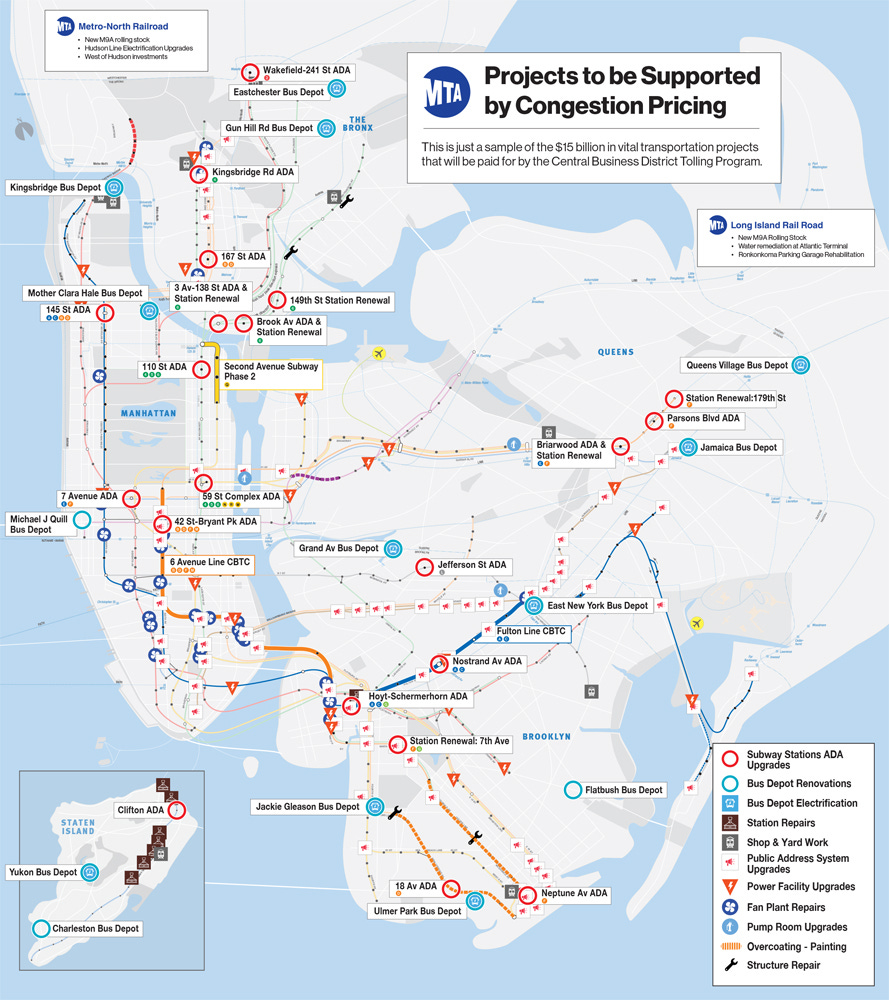How to save NYC from Governor Hochul’s misguided congestion pricing “pause”
Congestion pricing is still the best way to unclog New York’s streets, clean up our air, and fund critical transit upgrades
Yesterday, Governor Kathy Hochul announced her intention to “indefinitely pause” Manhattan’s congestion pricing program. Officially known as the Congestion Relief Zone, this initiative was set to charge tolls for vehicles entering Manhattan below 60th Street starting June 30, 2024. This delay threatens to derail a critical effort to improve New York City’s transportation infrastructure and environment.
Congestion pricing is legally required to raise revenue for $15 billion of capital projects to improve the transit system. Delaying it undermines significant potential benefits: faster bus rides, cleaner air, and crucial subway upgrades like station elevators, signal improvements, and the Second Avenue subway extension.
Governor Hochul cited the city’s “fragile” economic situation as the reason for the delay, suggesting that congestion pricing would threaten the city’s prosperity. This rationale is vague and unconvincing. Instead of congestion pricing, Hochul floated the prospect of an increased payroll tax on businesses in New York City.
My Disappointment and Frustration
As a strong supporter of congestion pricing, I find this indefinite delay deeply disappointing and frustrating. This move stalls progress on multiple fronts and deprives the city of necessary improvements. It attempts to shift the cost of transportation from drivers to businesses.
Congestion pricing has the potential to transform our daily commutes and the air we breathe. Faster buses mean less time wasted in traffic, and cleaner air translates to better health for all New Yorkers. Businesses were excited that less congestion would enable more reliably timed deliveries, and less time wasted stuck in traffic. Moreover, the billions of dollars earmarked for subway upgrades are essential for projects like installing elevators, improving signal reliability, and extending the Second Avenue subway.
The political calculus behind Hochul’s decision appears deeply flawed. The most generous interpretation is that she believes delaying congestion pricing will garner votes for Democrats in the November 2024 House races in suburban districts around New York City. However, this strategy seems misguided. Even in these suburbs, few residents commute to Manhattan by car, while many rely on transit. Pandering to a small minority of car commuters is unlikely to shift enough votes to significantly influence the election outcome, according to insiders on those suburban races.
The Legal Reality
Fortunately, New York is not a dictatorship, and Governor Hochul’s video announcement does not change the law on its own. The MTA is still required to implement congestion pricing, and the plan remains scheduled to start on June 30, 2024.
Only the state legislature can change the law, and only the MTA Board can alter the implementation schedule. Hochul can request changes, but she cannot mandate them.
The legislative session is nearly over, making it unlikely that the law will change. The focus now shifts to the MTA Board, which would need a majority vote to delay congestion pricing. The Board consists of 14 voting members, with the chair breaking ties:
6 votes from members appointed by the governor
4 votes from members appointed by the mayor of New York City
1 vote from a member appointed by the executive of Nassau County
1 vote from a member appointed by the executive of Suffolk County
1 vote from a member appointed by the executive of Westchester County
1 vote shared by members appointed by the executives of Dutchess, Orange, Rockland, and Putnam Counties
The MTA Board’s next meeting is on June 24 and 26. My understanding is this meeting is where any amendment to the congestion pricing plan will have to take place.
Taking Action
Now is the time for those who care about New York City's future to take a stand.
Email MTA Board members: Express your support for congestion pricing and urge them to maintain the June 30, 2024 start date. Click here for a pre-composed email you can edit.
Lobby your state legislators: Tell your state senator and assembly member that you care about congestion pricing and don’t want to increase NYC’s payroll taxes. Find their contact details, and give their office a call. It’s really easy! Just say “I’m a resident of XYZ neighborhood and I support congestion pricing. Please do everything you can to save it, and don’t raise payroll taxes.”
Follow advocacy groups: Riders Alliance and Transportation Alternatives are organizing advocates. Subscribing to their social profiles is a great way to stay updated.
Points to communicate to the MTA Board and your representatives:
Congestion pricing benefits the vast majority: Faster buses, improved air quality, reduced congestion, and funds for critical subway and bus system improvements. Even drivers benefit from less congested roads, allowing them to move through Manhattan more quickly. There are exemptions for vehicles transporting passengers with disabilities.
Financial prudence requires congestion pricing: The MTA has committed to projects relying on congestion pricing revenue and has issued bonds based on this assumption. Delaying congestion pricing will create financial instability.
Alternative funding sources are vaporware: Governor Hochul has floated implementing a tax on NYC businesses to cover the gap in the MTA’s budget, but this will hurt New York’s economy and has little chance of passing before the end of the legislative session.
Delaying congestion pricing is bad politics: The idea that delaying congestion pricing will help Democrats win House districts is deeply flawed.
This is our moment to ensure a better, more sustainable future for New York City. Your voice can make a difference — act now!



Who do we email to contact the MTA board? The link is just filling out the body of the email not to addressee.